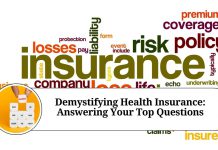Introduction:
Recruitment processes play a crucial role in shaping industries, and the insurance sector is no exception. In 2016, the insurance industry experienced a significant turning point with the recruitment of Administrative Officers (AOs). This blog explores the impact and significance of insurance AO recruitment in 2016, highlighting the transformative changes it brought to the industry.
The Emergence of Insurance AOs:
Prior to 2016, insurance companies primarily relied on a traditional approach to hiring, focusing on sales agents and specialized underwriters. However, as the industry evolved and customer demands shifted, insurance companies recognized the need for a new breed of professionals. Enter the Administrative Officer (AO) role – a position designed to bridge the gap between customer service and technical expertise.
Key Factors Influencing AO Recruitment:
- Evolving Customer Expectations: In the digital age, customers seek personalized and efficient services. Insurance AOs were recruited to cater to these evolving customer expectations, combining technical knowledge with a customer-centric approach.
- Technology Disruption: The rise of insurtech and digital transformation highlighted the need for insurance companies to adapt. AOs were recruited to navigate emerging technologies, such as artificial intelligence and automation, to streamline processes and enhance operational efficiency.
- Regulatory Compliance: Insurance is a highly regulated industry, and adherence to regulatory requirements is paramount. AOs played a vital role in ensuring compliance, managing documentation, and assisting in risk assessment processes.
Impacts of AO Recruitment in 2016:
- Enhanced Customer Experience: The introduction of AOs brought a renewed focus on customer experience. AOs were trained to understand customer needs, provide relevant information, and offer personalized solutions, leading to improved customer satisfaction and loyalty.
- Streamlined Operations: Insurance AOs were instrumental in streamlining internal processes through the effective use of technology. Automation and digital tools enabled AOs to handle routine administrative tasks, allowing other professionals to focus on specialized functions.
- Improved Risk Management: AOs played a crucial role in assessing risks and implementing preventive measures. Their understanding of regulatory compliance and attention to detail contributed to robust risk management practices within insurance companies.
- Skill Diversification: Insurance AO recruitment introduced a more diverse skill set to the industry. AOs possessed a combination of technical knowledge, customer service skills, and adaptability, broadening the talent pool and fostering innovation within the sector.
- Career Opportunities: The introduction of the AO role created new career opportunities for individuals interested in the insurance industry. It provided a pathway for professionals to develop a well-rounded skill set and pursue diverse roles within insurance companies.
Conclusion:
The recruitment of Administrative Officers (AOs) in the insurance industry in 2016 marked a significant turning point. It brought about transformative changes, aligning the sector with evolving customer expectations, technological advancements, and regulatory compliance. Insurance AOs have played a vital role in enhancing customer experience, streamlining operations, improving risk management practices, and diversifying the skill set within the industry. Looking back, it is evident that AO recruitment in 2016 set the stage for a more customer-centric, efficient, and innovative insurance industry.
Other Related Blogs: Section 144B Income Tax Act
Frequently Asked Questions (FAQs)
Q.What is an Administrative Officer (AO) in the insurance industry?
An Administrative Officer (AO) is a role introduced in the insurance industry to bridge the gap between customer service and technical expertise. AOs are responsible for handling administrative tasks, managing customer inquiries, ensuring regulatory compliance, and supporting risk assessment processes.
Q.Why did insurance companies start recruiting AOs in 2016?
Insurance companies recognized the need to adapt to changing customer expectations and technological advancements. AOs were recruited to provide personalized services, streamline operations, enhance risk management practices, and navigate emerging technologies.
Q.What qualifications were required for insurance AO recruitment in 2016?
The specific qualifications varied among insurance companies, but common requirements included a bachelor’s degree in a relevant field, strong communication and problem-solving skills, attention to detail, and knowledge of insurance products and regulations.
Q.How did AO recruitment impact the customer experience?
AO recruitment focused on improving customer experience by training AOs to understand customer needs, provide relevant information, and offer personalized solutions. This led to enhanced customer satisfaction and loyalty.
Q.Did AO recruitment lead to job losses in the insurance industry?
While AO recruitment introduced new roles and skill sets, it did not necessarily result in widespread job losses. Instead, it aimed to optimize processes, allowing employees to focus on specialized functions while AOs handled routine administrative tasks.
Q.What role did technology play in AO recruitment in 2016?
Technology played a significant role in AO recruitment. Insurance companies sought candidates with a familiarity with emerging technologies, such as artificial intelligence and automation, to leverage digital tools for improved efficiency and operational effectiveness.
Q.How did AO recruitment contribute to risk management in the insurance industry?
AOs played a vital role in risk management by assessing risks, ensuring regulatory compliance, and implementing preventive measures. Their attention to detail and understanding of compliance requirements helped insurance companies mitigate risks effectively.
Q.What career opportunities did AO recruitment create in the insurance industry?
AO recruitment created new career opportunities for individuals interested in the insurance industry. It provided a pathway for professionals to develop a diverse skill set and pursue various roles within insurance companies, including customer service, risk assessment, and operations management.
Q.Did AO recruitment lead to cost savings for insurance companies?
AO recruitment aimed to streamline operations and automate routine tasks, which, in turn, led to potential cost savings for insurance companies. By leveraging technology and optimizing processes, companies could allocate resources more efficiently.
Q.How did AO recruitment contribute to innovation in the insurance industry?
AO recruitment introduced a more diverse skill set to the insurance industry, fostering innovation. The combination of technical knowledge, customer service skills, and adaptability brought fresh perspectives and ideas, driving innovation in processes, products, and services.




















